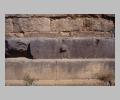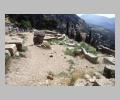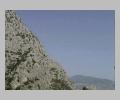
Interior view, Temple of Apollo. Delphi.

Delphi.
| Summary: | Panhellenic Sanctuary of Pythian Apollo. |
| Type: | Sanctuary |
| Region: | Phocis |
Periods:
Geometric
Archaic
Classical
Hellenistic
Roman
Physical:
Located in a dramatic setting on S slopes of Mt. Parnassos, Delphi was regarded in antiquity as the center of the world. The recognition of Delphi and the fame of its oracle extended beyond the borders of the Greek world and gave the sanctuary an international standing, whereas the rival sanctuary of Olympia had a more national Greek character. The main temenos of Apollo contained numerous treasuries and monuments. The Sacred Way led through the precinct to the altar and temple of Apollo. Other buildings include a theater, stadium, and bouleuterion. E of Apollo's precinct is the Kastalian Spring and fountainhouse where visitors purified themselves. SE of the spring is the smaller temenos of Athena Pronaia (the so-called Marmaria). The Pythian Games, one of the four great athletic and drama festivals of ancient Greece, was held every 4 years. The Pythia, an elderly priestess of Apollo, was the most famous and respected oracle in the ancient world.
Description:
Archaeological excavation has shown that a Mycenaean cult center existed at Delphi under the later temenos of Athena Pronaia, but there is no clear evidence for continuity into the 8th century B.C. nor for the identity of the original deity. Tradition and myth, however, report that the site at Delphi, originally called Pytho, was first sacred to Poseidon and Ge (Mother Earth) and that an oracle presided near a cave inhabited by Python, the serpent son of Ge.
In the 8th century B.C. the cult of Pythian Apollo developed and shortly thereafter, according to tradition, priests arrived from Knossos and introduced the cult of Apollo Delphinios (dolphin) which effected the sanctuary's change in name.
In the 8th and 7th centuries the sanctuary prospered, in large part, because the oracle played an important role in advising the Greek cities on colonization ventures. Numerous buildings, including the first ashlar temple of Apollo, were added to the sanctuary and dedications and wealth accumulated. The fame of the Delphic oracle spread throughout the civilized world.
In 600-586 B.C. the 1st Sacred War resulted in the control of the sanctuary being passed to the Amphictyonic League (a federation of 12 city states, including Athens and Sparta). The Amphictyony reorganized and presided over the Pythian Games (previously instituted in honor of Apollo, Artemis, and Leto, and 1 of the 4 major games-festivals of the Greeks). The games were now held every 4 years instead of every 8, and the chariot race was added.
The 8th century temple of Apollo which had been destroyed by fire was rebuilt in 548 B.C. and the sanctuary area was enlarged to its present size with funds collected throughout the Mediterranean world. During the 6th century the fame and prosperity of the sanctuary continued to grow.
In 480 B.C. a miraculous landslide halted a Persian raid on the sanctuary. In 373 the temple of Apollo was destroyed by earthquake and again rebuilt with international donations. The 4th century became a 2nd period of architectural enhancement and prosperity for the sanctuary. In 279 B.C. the sanctuary was again miraculously saved from a barbarian (Gauls) pillage. The 3rd century brought additional architectural development at the sanctuary through the contributions of the Pergamon kings.
After the war of 595-586, 3 more Sacred Wars (448, 356, 340 B.C.) were fought among various Greek city-states over the control of the sanctuary and its sacred lands in the Krisaean plain below. Finally in 189 B.C. the Romans replaced the Aetolians as protectors of Delphi and the fortunes of the sanctuary then fluctuated according to the attitudes of the succeeding Roman rulers. The general Sulla plundered the site in 86 B.C. and Nero carried off over 500 bronze statues in 51 A.D., while Hadrian and the Antonines attempted to restore the past glory of the sanctuary. In general, however, the wealth of the sanctuary and the power of the oracle continued to decline under Roman rule and the site suffered its final blow with the edict of Theodosius, ca. 390 A.D.
Exploration:
Cyriac of Ancona copied inscriptions in 1436; in 1676, the site was rediscovered by Wheler and Spon; preliminary study was carried out by various scholars in the 19th century; excavations: 1892 - present, French School of Archaeology.
Sources Used:
Other Bibliography:



